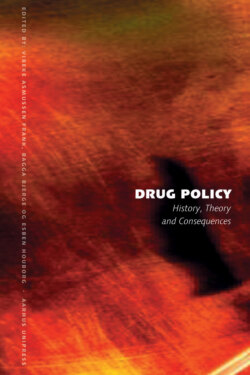Читать книгу Drug Policy - Группа авторов - Страница 6
INTRODUCTION: DANISH DRUG POLICY – HISTORY, THEORY, AND THE INTERNATIONAL FRAMEWORK
ОглавлениеDanish drug policy has seen considerable changes since the turn of the century. These changes have been on two fronts. First, formal government policy has undergone a number of changes which have made Danish drug policy more restrictive – although on the other hand the political focus on treatment which started in the mid-1990s has continued, for instance by making drug treatment a social right and making heroin substitution treatment possible. These developments can, as we will show below, be understood by applying a number of well-known concepts in drug policy analysis. The second front in the development of drug policy in Denmark concerns a veritable proliferation of drug policies. An increasing number of players and institutions such as parents, local communities, educational institutions, sports clubs and private enterprises are now engaged in developing and carrying out drug policies. Sometimes this is a consequence of new governmental strategies on behalf of public authorities. But frequently it is also because drugs and living with drugs are now an immediate concern for many people and institutions. Not only in relation to the dangers of drug use, but also a focus on drug use and drug dealing as a nuisance in local communities. The development of Danish drug policy on these two fronts makes it very relevant to study Danish drug policy today. Without claiming to present a comprehensive account of these various developments, this volume will include contributions that supply some of the first pieces of the increasingly complex puzzle of Danish drug policy today. This will be done under three headings dealing with various levels of drug policy. First, the ways in which drug policies are developed in various institutional settings like prisons and social institutions for homeless people. These studies deal with the way drug policies vary as they are developed and practised in various institutional conditions, and the way particular conditions (the prison setting, for instance) can place severe constraints on the kind of drug policies that can be implemented. Secondly, we include studies of the way in which drug policies are developed and carried out at local level in two Danish cities, and the effects and consequences of these local drug policies. The third and final section deals with drug policy more on a macro level in terms of the historical development of modern Danish drug policy, with regard to legislation, law enforcement and treatment. It also contains a contribution from the USA, which shows one particular version of how drug policy proliferates into all sorts of different policies and practices. In this introduction we will provide a framework for these various contributions to this volume. We will elaborate on the current state of Danish drug policy on the two fronts mentioned above – the formal drug policy of the Danish government and the proliferation of drug policies beyond the state. It is the opinion of the editors that these developments in Danish drug policy provide a fertile basis for the articulation of new empirical problems and analytical questions in drug policy analysis, some of which will be presented. When discussing the framework and conditions of drug policy it is not possible to ignore the international drug control system, which puts a number of constraints on how problems can be defined and which solutions can be developed both nationally and locally. This introduction will therefore also present this system to readers who are not familiar with it, and discuss the room for variety in drug policy, which this system leaves.
